

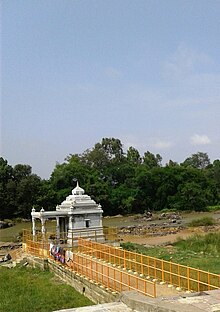
The Hemavati is a river in southern India near Karnataka [1] and an important tributary of the Kaveri.



The Hemavati is a river in southern India near Karnataka [1] and an important tributary of the Kaveri.
The source of the Hemavati River lies in the Western Ghats (Javali village) at an elevation of about 1,230 metres (4,040 ft). [2] Located in Mudigere taluk of Chikmagalur District in the state of Karnataka, it flows through Hassan District where it is joined by its chief tributary the Yagachi River and then into Mandya district before joining the Kaveri near Krishnarajasagara. It is approximately 245 km long and has a drainage area of about 5,410 km². [3]
Gorur dam across the Hemavati was completed in 1979 above Gorur in Hassan district and downstream from the Yagachi confluence. The dam is a masonry dam with a central spillway through 6 radial gates. It is 44.5 meters in height and 4692 meters long with an area of 9162 hectares. The reservoir has a live storage capacity of 35.7 TMC. [4] The dam provides irrigation and drinking water not only for major portion of Hassan and Mandya districts, but also to far away regions of Tumkur district, that fall under Krishna River basin. [5]
The Shettihalli Rosary Church, which was submerged during the construction of the dam, can be seen only when the water level is low during the summer months. The church was constructed in the Gothic architectural style by French missionaries in the 1860s. The church was abandoned in 1960 when the government decided to build the dam. When the water level is low coracles are used to go inside the church. [6] [7]
12°34′N76°27′E / 12.567°N 76.450°E

The Kaveri is one of the major Indian rivers flowing through the states of Karnataka and Tamil Nadu. The Kaveri River rises at Talakaveri in the Brahmagiri range in the Western Ghats, Kodagu district of the state of Karnataka, at an elevation of 1,341 m above mean sea level and flows for about 800 km before its outfall into the Bay of Bengal. It reaches the sea in Poompuhar, in Mayiladuthurai district. It is the third largest river – after Godavari and Krishna – in southern India, and the largest in the state of Tamil Nadu, which, on its course, bisects the state into north and south. In ancient Tamil literature, the river was also called Ponni.

Krishna Raja Sagara, also popularly known as KRS, is a lake and the dam that creates it. They are close to the settlement of Krishna Raja Sagara in the Indian State of Karnataka. The gravity dam made of surki mortar is below the confluence of river Kaveri with its tributaries Hemavati and Lakshmana Tirtha, in the district of Mandya.

Penna is a river of southern India. This is a unique river in world where after originating from Nandi hills, it flows as two different streams, one in North and South directions. The Penna rises in the Nandi Hills in Chikkaballapur District of Karnataka state, and runs north and east through the states of Karnataka and Andhra Pradesh to empty into bay of bengal in Andhra Pradesh. It is 597 kilometres (371 mi) long, with a drainage basin covering 55,213 km2: 6,937 km2 in Karnataka and 48,276 km2 in Andhra Pradesh. Along with this main stream there is another stream south towards Tamilnadu with the name Then Pennai or south Pennar which further moves towards the east to empty into the Bay of Bengal.The Penna river basin lies in the rain shadow region of Eastern Ghats and receives 500 mm average rainfall annually.

The Mettur Dam is one of the largest dams in India and also the largest in Tamil Nadu, located across the river Kaveri where it enters the plains. Built in 1934, it took 9 years to complete. Maximum height and width of the dam are 214 and 171 feet, respectively. The dam receives inflows from its own catchment area, Kabini Dam and Krishna Raja Sagara Dams located in Karnataka. There is a park at the base of the dam called Ellis Park maintained by the Tamil Nadu Public Works Department. It provides irrigation and drinking water facilities for more than 12 districts of Tamil Nadu and hence is revered as the life and livelihood-giving asset of Tamil Nadu.

Hassan is one of the 31 districts of Karnataka, India. The district headquarter is Hassan. It was carved out from Mysore district in the year 1866, during the Commissioner's Rule of Mysore (1831-81).
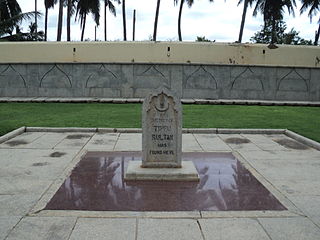
Mandya District is an administrative district of Karnataka, India. The district is bordered on the south by Mysore and Chamarajangar districts, on the west by Hassan District, on the north by Tumkur District and on the east by Ramanagara district. The district Mandya was carved out of larger Mysore district in the year 1939.

Bayaluseeme or Bayalu Seeme is the area lying to the east of Malenadu, a region of Karnataka state in India. The area is largely open plain, with few hillocks. It includes the districts of Bangalore, Bagalkot, Bijapur, Chitradurga, Davanagere, Dharwad, Gadag, Hassan, Haveri, Mandya, Mysore, and Tumkur.
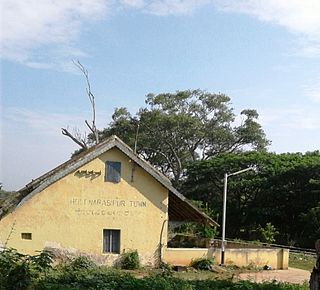
Holenarasipura is a town and taluk in Hassan district of Karnataka. The town is situated on the banks of the Hemavati, one of the tributaries of the Kaveri.
Arkalgud, also known as Arakalagudu is a panchayat town and is one among the eight taluks of Hassan district in the state of Karnataka, India. It is situated 30 km from Hassan, 181 km from Mangalore and 195 km from Bangalore. The river Hemavati forms the entire northern boundary of the Taluk; river Kaveri runs through a portion of the south. It is well connected by road to many towns and cities of Karnataka. Hassan Junction railway station is the nearest major railway station and Kannur International Airport is the nearest airport at 150 kilometres.
Krishnarajasagara is a town in Mandya district in the Indian state of Karnataka.
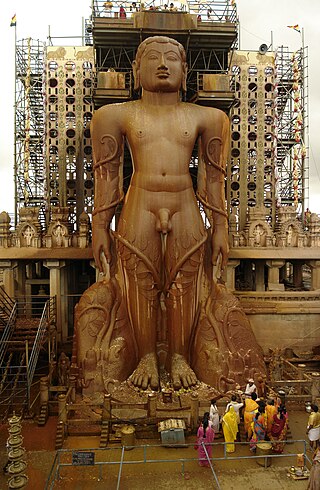
Karnataka, the sixth largest state in India, has been ranked as the third most popular state in the country for tourism in 2014. It is home to 507 of the 3600 centrally protected monuments in India, second only to Uttar Pradesh. The State Directorate of Archaeology and Museums protects an additional 752 monuments and another 25,000 monuments are yet to receive protection.

The Indian State of Karnataka is located between 11°30' North and 18°30' North latitudes and between 74° East and 78°30' East longitude.It is situated on a tableland where the Western Ghats and Eastern Ghats converge into the complex, in the western part of the Deccan Peninsular region of India. The State is bounded by Maharashtra and Goa States in the north and northwest; by the Lakshadweep Sea in the west; by Kerala in the south-west and Tamil Nadu in the south and south-east, Andhra Pradesh in the south-east and east and Telangana in the north-east. Karnataka extends to about 850 km (530 mi) from north to south and about 450 km (280 mi) from east to west.
Kannambadi was a village near Mysore in the Mandya district that was chosen as the site of the Krishna Raja Sagara dam in 1910. The dam is therefore called Kannambadi Katte in Kannada.

The Lal Bahadur Shastri Dam is also known as Almatti Dam is a hydroelectric project on the Krishna River in North Karnataka, India which was completed in July 2005. The target annual electric output of the dam is 560 MU.

Shimsha is a river that flows in the state of Karnataka, India. It is one of the tributaries of the river Kaveri, which is one of the major rivers of South India. The river originates in the southern part of the Devarayanadurga hill in the Tumkur district of Karnataka and flows for about 221 km (137 mi). before joining the river Kaveri.
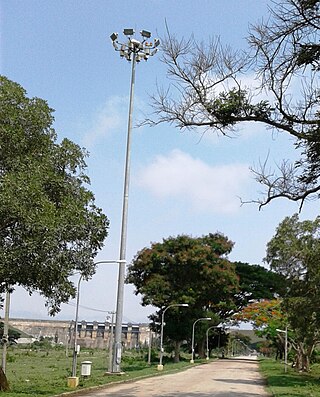
The Gorur Dam is constructed across the Hemavati river in 1979. The dam is located in Gorur village of Arkalgud Taluk, Hassan district, Karnataka.

The following outline is provided as an overview of and topical guide to Karnataka:
The Yagachi River is a river in Karnataka, India. It is a major tributary of Hemavati river. It rises in the Baba Budan Hill Range near the city of Chickmagaluru, flows through Belur taluk, Hassan District. It joins the Hemavati River, near Gorur. It has a small tributary called Votehole or Watehole. Votehole dam is built on the stream (1.51Tmcft) near Rajanahalli. The length of Left bank and Right bank canal of Votehole is 10 km & 40 km respectively.

Shettihalli Church is located 2km from Shettihalli, Hassan, in Karnataka. Built in the 1860s by the French missionaries in India, the church is a magnificent structure of Gothic Architecture. After the construction of the Hemavati Dam and Reservoir in 1960 the church was Submerged under water due to the dam It has since then become a famous tourist spot where people flock to see the half submerged church during monsoon. It is also known as The Submerged Church and The Floating Church.
